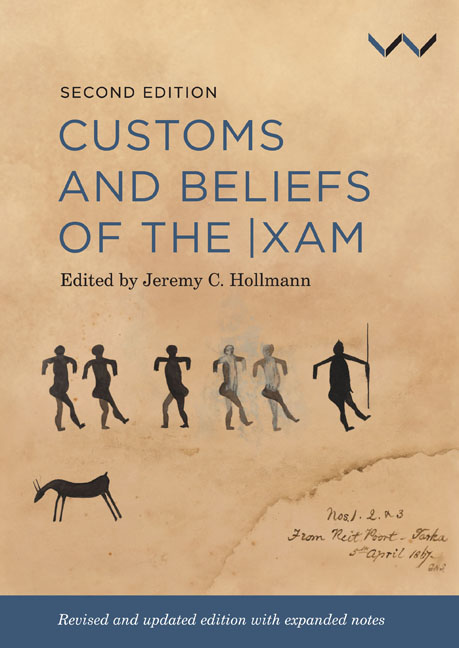Book contents
- Frontmatter
- Dedication
- Contents
- Acknowledgements
- Foreword To The Second Edition
- Foreword To The First Edition
- Introduction
- Contributors
- The |Xam Language
- The People In The Notebooks
- Part 1 Baboons
- Part 2 The Lion
- Part 3 Game Animals
- Part 4 Omens, Windmaking, Clouds
- Part 5 Rain
- Part 6 Rainmaking
- Part 7 Sorcerers
- Part 8 More About Sorcerers and Charms
- Part 9 Special Speech of Animals and Moon
- Appendix 1 |Xam Grammar
- Appendix 2 Summary of The Narratives
- References
- Index
Part 3 - Game Animals
Published online by Cambridge University Press: 24 November 2023
- Frontmatter
- Dedication
- Contents
- Acknowledgements
- Foreword To The Second Edition
- Foreword To The First Edition
- Introduction
- Contributors
- The |Xam Language
- The People In The Notebooks
- Part 1 Baboons
- Part 2 The Lion
- Part 3 Game Animals
- Part 4 Omens, Windmaking, Clouds
- Part 5 Rain
- Part 6 Rainmaking
- Part 7 Sorcerers
- Part 8 More About Sorcerers and Charms
- Part 9 Special Speech of Animals and Moon
- Appendix 1 |Xam Grammar
- Appendix 2 Summary of The Narratives
- References
- Index
Summary
The notion of a ‘game animal’ is a European one. It was formerly applied to animals hunted for ‘sport’ (Brooks 2005: note 1), such as buffalo, elephant, lion and so on; nowadays, it is commonly used in trophy hunting and wildlife tourism. Another term – ‘bushmeat’ – refers mostly to smaller animals hunted to provide meat for the household or to sell. Neither of these concepts adequately translates what Diäǃkwɑin and |hɑŋǂkɑssʼo speak of as ʘpwɑitǝn (‘game, meat, flesh, body’, Bleek 1956: 685) or tʃweŋ (‘things, game’, Bleek 1956: 238; sometimes spelled tchueŋ). Although Lucy Lloyd and Dorothea Bleek do include ‘game’ as a translation for both words, I suggest that it is not a suitable concept for expressing the |xɑm narrators’ knowledge about and relations with these animals. Louis Liebenberg points this out:
The attitudes of trophy hunters also contrast sharply with those of hunter-gatherers. The very essence of hunting a ‘trophy’ is one of boastfulness. (One need only look at the way they pose alongside their ‘kills’ for photographs.) In contrast, the successful hunter in a hunter-gatherer community was expected to show humility and gentleness.
(Liebenberg 1990: viii)The narratives selected for Part 3 deal directly with the practices and experiences that Dorothea considered fit for the categories of ‘customs’ and ‘beliefs’, rather than ‘hunting’.1 Her selections – three narratives by Diäǃkwɑin and two by |hɑŋǂkɑssʼo – detail attitudes and beliefs about eland and springbok that go beyond killing them for their meat and skins. These narratives suggest a more complex relationship between people, eland and springbok than that of killing and consumption.
The eland's creation
The eland (Taurotragus oryx) is the largest of the antelopes. A mature male eland can weigh up to 900 kilograms and stand 1.7 metres at the shoulder. Eland are in the same family (Bovinae) as cattle – indeed, Richard Estes (1999: 154) refers to the eland as an ‘antelope in ox's clothing’ because of the many similarities between eland and cattle (Lewis-Williams 1981: 106 discusses these). |xɑm and other indigenous click-speaking people hold the eland in high regard partly because it has so much fat (and meat):
One of the most important attributes of the eland – especially the male – is its fat. This is the characteristic that most excites the ǃKung [the Ju|ʼhoɑnsi in Botswana and Namibia]… .
- Type
- Chapter
- Information
- Customs and Beliefs of the |xam , pp. 109 - 148Publisher: Wits University PressPrint publication year: 2022



